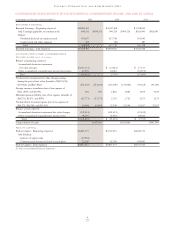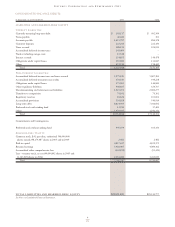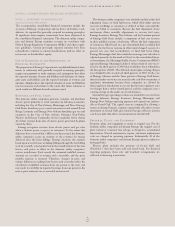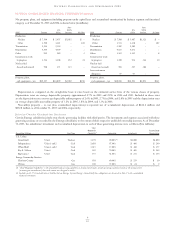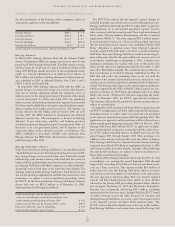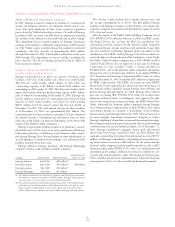Entergy 2005 Annual Report Download - page 70
Download and view the complete annual report
Please find page 70 of the 2005 Entergy annual report below. You can navigate through the pages in the report by either clicking on the pages listed below, or by using the keyword search tool below to find specific information within the annual report.
ENTERGY CORPORATION AND SUBSIDIARIES 2005
*
66
or commitments to provide additional financial support. See Note 12
to the consolidated financial statements for additional information
regarding Entergy’s equity method investments.
DERIVATIVE FINANCIAL INSTRUMENTS
AND COMMODITY DERIVATIVES
SFAS 133, “Accounting for Derivative Instruments and Hedging
Activities,” requires that all derivatives be recognized in the balance
sheet, either as assets or liabilities, at fair value, unless they meet the
normal purchase, normal sales criteria. The changes in the fair value
of recognized derivatives are recorded each period in current earnings
or other comprehensive income, depending on whether a derivative
is designated as part of a hedge transaction and the type of
hedge transaction.
Contracts for commodities that will be delivered in quantities
expected to be used or sold in the ordinary course of business,
including certain purchases and sales of power and fuel, are not
classified as derivatives. These contracts are exempted under the
normal purchase, normal sales criteria of SFAS 133. Revenues and
expenses from these contracts are reported on a gross basis in the
appropriate revenue and expense categories as the commodities are
received or delivered.
For other contracts for commodities in which Entergy is hedging
the variability of cash flows related to a variable-rate asset, liability,
or forecasted transactions that qualify as cash flow hedges, the
changes in the fair value of such derivative instruments are reported
in other comprehensive income. To qualify for hedge accounting,
the relationship between the hedging instrument and the hedged
item must be documented to include the risk management objective
and strategy and, at inception and on an ongoing basis, the effective-
ness of the hedge in offsetting the changes in the cash flows of the
item being hedged. Gains or losses accumulated in other compre-
hensive income are reclassified as earnings in the periods in which
earnings are affected by the variability of the cash flows of the
hedged item. The ineffective portions of all hedges are recognized
in current-period earnings.
IMPAIRMENT OF LONG-LIVED ASSETS
Entergy periodically reviews long-lived assets held in all of its busi-
ness segments whenever events or changes in circumstances indicate
that recoverability of these assets is uncertain. Generally, the deter-
mination of recoverability is based on the undiscounted net cash
flows expected to result from such operations and assets. Projected
net cash flows depend on the future operating costs associated
with the assets, the efficiency and availability of the assets and
generating units, and the future market and price for energy over
the remaining life of the assets. See Note 11 to the consolidated
financial statements for a discussion of asset impairments recognized
by Entergy in 2005 and 2004.
RIVER BEND AFUDC
The River Bend AFUDC gross-up is a regulatory asset that repre-
sents the incremental difference imputed by the Louisiana Public
Service Commission (LPSC) between the AFUDC actually recorded
by Entergy Gulf States on a net-of-tax basis during the construction
of River Bend and what the AFUDC would have been on a pre-tax
basis. The imputed amount was only calculated on that portion
of River Bend that the LPSC allowed in rate base and is being
amortized over the estimated remaining economic life of River Bend.
TRANSITION TO COMPETITION LIABILITIES
In conjunction with electric utility industry restructuring activity in
Texas, regulatory mechanisms were established to mitigate potential
stranded costs. Texas restructuring legislation allowed depreciation
on transmission and distribution assets to be directed toward gener-
ation assets. The liability recorded as a result of this mechanism
is classified as “transition to competition” deferred credits on the
balance sheet.
REACQUIRED DEBT
The premiums and costs associated with reacquired debt of the
domestic utility companies and System Energy (except that portion
allocable to the deregulated operations of Entergy Gulf States) are
included in regulatory assets and are being amortized over the life of
the related new issuances, in accordance with ratemaking treatment.
FOREIGN CURRENCY TRANSLATION
All assets and liabilities of Entergy’s foreign subsidiaries are translated
into U.S. dollars at the exchange rate in effect at the end of the period.
Revenues and expenses are translated at average exchange rates
prevailing during the period. The resulting translation adjustments
are reflected in the comprehensive income component of shareholders’
equity. Current exchange rates are used for U.S. dollar disclosures of
future obligations denominated in foreign currencies.
NEW ACCOUNTING PRONOUNCEMENTS
SFAS 123R, “Share-Based Payment” was issued in December 2004
and is effective for Entergy in the first quarter of 2006. SFAS 123R
requires all employers to account for share-based payments at fair
value and also provides guidance on determining the assumptions to
estimate fair value. SFAS 123R also provides guidance on how to
account for differences in the amounts of deferred taxes initially
recorded when the options are recorded as expense and the amount
of expense deducted on a company’s tax return when the options are
actually exercised. Entergy began voluntarily expensing its stock
options effective January 1, 2003 in accordance with SFAS 148,
“Stock-Based Compensation – Transition and Disclosure.” Entergy
is in the process of finalizing its evaluation of the reporting and dis-
closure issues resulting from the adoption of SFAS 123R but does
not expect the effect of the adoption of this standard to be material
to Entergy’s financial position or results of operations.
As discussed in Note 8 to the consolidated financial statements,
Entergy adopted FIN 47, “Accounting for Conditional Asset
Retirement Obligations” during the fourth quarter of 2005. FIN 47
requires that a liability be recorded currently for costs associated
with a legal obligation to perform an asset retirement obligation
activity for which the timing and (or) method of settlement are con-
ditional on a future event that may or may not be within the control
of the entity but for which the obligation to perform the asset retire-
ment activity is unconditional. FIN 47 requires that a liability be
recognized for the fair value of a conditional asset retirement obli-
gation if the fair value of the liability can be reasonably estimated.
SFAS 151, “Inventory Costs – an amendment of ARB No. 43,
Chapter 4” and SFAS 153, “Exchanges of Nonmonetary Assets”,
were issued during the fourth quarter of 2004 and are effective for
Entergy in 2006 and 2005, respectively. SFAS 154, “Accounting
Changes and Error Corrections” was issued in 2005 and is effective
for Entergy in 2006. Entergy does not expect the impact of the
issuance of these standards to be material to its financial position or
results of operations.
NOTES to CONSOLIDATED FINANCIAL STATEMENTS continued



